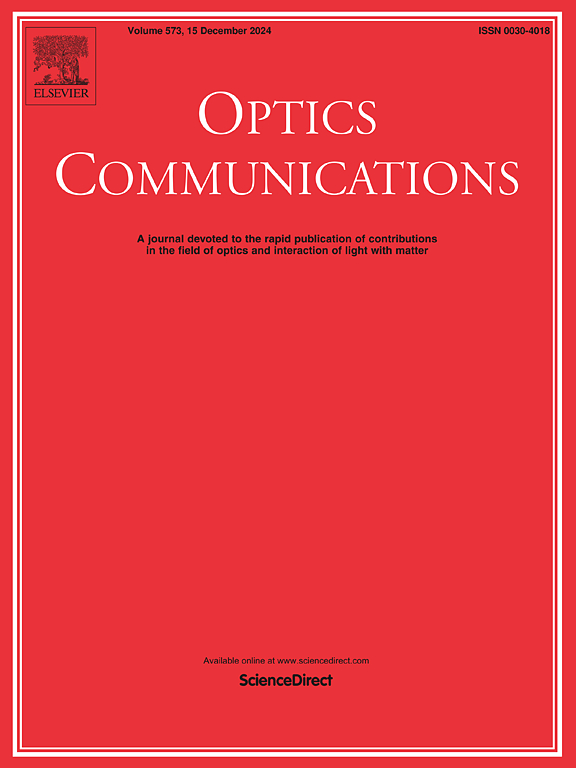用于高效窄带和宽带吸收的多功能双向超材料完美吸收器
IF 2.5
3区 物理与天体物理
Q2 OPTICS
引用次数: 0
摘要
在这项研究中,我们介绍了一种双向超材料完美吸收器,能够同时实现四窄带和宽带吸收。与传统的单波段超材料完美吸收器不同,我们提出的设计可以在四种不同的窄带和宽带吸收模式之间切换。吸收器由多层平面结构组成,顶层为光栅结构。当从上方照射时,吸收剂在575.7 nm、625.1 nm、929.5 nm和1667.4 nm波长处呈现出四个吸收峰,对应的吸收率分别为99.66%、99.82%、99.85%和92.21%。我们通过时域有限差分(FDTD)仿真和耦合模式理论(CMT)拟合验证了我们的设计,发现两种方法之间有很好的一致性。窄带完全吸收是局域表面等离子体共振(LSPR)、间隙共振和F-P腔共振协同作用的结果。此外,我们的分析表明,结构的敏感性是非常高的。我们采用CIE(国际光度委员会)颜色模型,将可见光范围内的反射光谱转换为颜色估定值,从而增强了结构的美学吸引力。我们观察到,改变光栅厚度会产生丰富色彩的光谱。值得注意的是,当电磁波从器件背面入射时,其吸收带宽为1634.2 nm,平均吸收率为98.54%。电磁场分析将这种有效的宽带吸收归因于F-P腔共振。值得注意的是,在一定的制造公差范围内,吸收器保持其宽带吸收特性。在AM 1.5太阳辐射光谱下,吸收体的能量吸收率达到95.98%,在1800 K温度下,吸收体的热辐射率高达98.67%。此外,窄带吸收与极化无关,而宽带吸收与极化无关。鉴于这些特性,所提出的双向吸收剂在传感、检测、光伏发电和太阳能热能转换方面的应用具有重要的前景。本文章由计算机程序翻译,如有差异,请以英文原文为准。
A multifunctional bidirectional metamaterial perfect absorber for efficient narrowband and broadband absorption
In this study, we introduce a bidirectional metamaterial perfect absorber capable of achieving both four narrowband and broadband absorption. Unlike conventional single-band metamaterial perfect absorbers, our proposed design enables switching between four distinct narrowband and broadband absorption modes. The absorber consists of several layers of planar structures, with the top layer featuring a grating structure. When illuminated from above, the absorber exhibits four absorption peaks at wavelengths of 575.7 nm, 625.1 nm, 929.5 nm, and 1667.4 nm, corresponding to absorption rates of 99.66 %, 99.82 %, 99.85 %, and 92.21 %, respectively. We validate our design through finite-difference time-domain (FDTD) simulations and coupled mode theory (CMT) fitting, finding excellent agreement between the two methods. The observed narrowband perfect absorption arises from the synergistic effects of local surface plasmon resonance (LSPR), gap resonance, and Fabry-Perot (F–P) cavity resonance. Furthermore, our analysis reveals that the structural sensitivity is notably high. Employing the CIE (International Photometric Commission) color model, we convert the reflected spectra in the visible range into color estimation values, thereby enhancing the aesthetic appeal of the structure. We observe that varying the grating thickness results in a spectrum of rich colors. Notably, when electromagnetic waves are incident from the back of the device, it demonstrates an exceptionally wide absorption bandwidth of 1634.2 nm, with an average absorption rate of 98.54 %. Electromagnetic field analysis attributes this efficient broadband absorption to F–P cavity resonance. Remarkably, within a certain manufacturing tolerance range, the absorber retains its broadband absorption characteristics. Under the AM 1.5 solar radiation spectrum, the energy absorption rate reaches 95.98 %, while at a temperature of 1800 K, the absorber exhibits a high thermal emissivity of 98.67 %. Additionally, the narrowband absorption is polarization-dependent, whereas the broadband absorption is polarization-independent. Given these attributes, the proposed bidirectional absorber holds significant promise for applications in sensing, detection, photovoltaic power generation, and solar thermal energy conversion.
求助全文
通过发布文献求助,成功后即可免费获取论文全文。
去求助
来源期刊

Optics Communications
物理-光学
CiteScore
5.10
自引率
8.30%
发文量
681
审稿时长
38 days
期刊介绍:
Optics Communications invites original and timely contributions containing new results in various fields of optics and photonics. The journal considers theoretical and experimental research in areas ranging from the fundamental properties of light to technological applications. Topics covered include classical and quantum optics, optical physics and light-matter interactions, lasers, imaging, guided-wave optics and optical information processing. Manuscripts should offer clear evidence of novelty and significance. Papers concentrating on mathematical and computational issues, with limited connection to optics, are not suitable for publication in the Journal. Similarly, small technical advances, or papers concerned only with engineering applications or issues of materials science fall outside the journal scope.
 求助内容:
求助内容: 应助结果提醒方式:
应助结果提醒方式:


